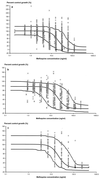Mefloquine pharmacokinetic-pharmacodynamic models: implications for dosing and resistance
- PMID: 11083649
- PMCID: PMC90214
- DOI: 10.1128/AAC.44.12.3414-3424.2000
Mefloquine pharmacokinetic-pharmacodynamic models: implications for dosing and resistance
Abstract
Antimalarial resistance develops and spreads when spontaneously occurring mutant malaria parasites are selected by concentrations of antimalarial drug which are sufficient to eradicate the more sensitive parasites but not those with the resistance mutation(s). Mefloquine, a slowly eliminated quinoline-methanol compound, is the most widely used drug for the treatment of multidrug-resistant falciparum malaria. It has been used at doses ranging between 15 and 25 mg of base/kg of body weight. Resistance to mefloquine has developed rapidly on the borders of Thailand, where the drug has been deployed since 1984. Mathematical modeling with population pharmacokinetic and in vivo and in vitro pharmacodynamic data from this region confirms that, early in the evolution of resistance, conventional assessments of the therapeutic response </=28 days after treatment underestimate considerably the level of resistance. Longer follow-up is required. The model indicates that initial deployment of a lower (15-mg/kg) dose of mefloquine provides a greater opportunity for the selection of resistant mutants and would be expected to lead more rapidly to resistance than de novo use of the higher (25-mg/kg) dose.
Figures










References
-
- Day N P J, Diep P T, Ly P T, Sinh D X, Loc P P, Chuong L V, Chau T T H, Mai N T H, Bethell D B, Phu N H, Hien T T, White N J. Clearance kinetics of parasites and pigment-containing leukocytes in severe malaria. Blood. 1996;88:4694–4700. - PubMed
-
- Hoshen M B, Stein W D, Ginsburg H. Modelling the chloroquine chemotherapy of falciparum malaria: the value of spacing a split dose. Parasitology. 1998;116:407–416. - PubMed
-
- Karbwang J, White N J. Clinical pharmacokinetics of mefloquine. Clin Pharmacokinet. 1990;19:264–279. - PubMed
-
- Kitchen S F. The infection in the intermediate host: symptomatology, falciparum malaria. In: Moulton F R, editor. A symposium on human malaria. Washington, D.C.: American Association for the Advancement of Science; 1941. pp. 196–207.
Publication types
MeSH terms
Substances
Grants and funding
LinkOut - more resources
Full Text Sources
Medical

